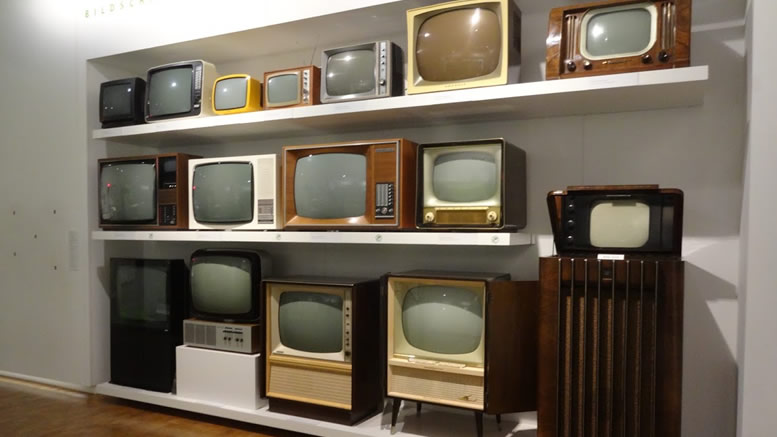 The cathode ray tube or CRT, invented by Karl Ferdinand Braun, is the display device used in most computer displays, video monitors, televisions and oscilloscopes.
The cathode ray tube or CRT, invented by Karl Ferdinand Braun, is the display device used in most computer displays, video monitors, televisions and oscilloscopes.
The earliest version of the CRT was a cold-cathode diode, a modification of the Crookes tube (see X-ray) with a phosphor-coated screen, sometimes called a Braun tube. The first version to use a hot cathode was developed by J. B. Johnson (who gave his name to the term Johnson noise) and H. W. Weinhart of Western Electric and became a commercial product in 1922.
Early tubes were generally round in shape, this was due to the fact that it was easier to make a round shape as apposed to a square one. Today flat square edge tubes are quite common but are more expensive due to the extra glass and work involved in manufacture.
Cathode rays are streams of high-speed electrons emitted from the heated cathode of a vacuum tube. In a cathode ray tube, the electrons are carefully directed into a beam, and this beam is deflected by a magnetic field to scan the surface at the viewing end (anode), which is lined with phosphorescent material (usually based on transition metals or rare earths). When the electrons hit this material, light is emitted.
In case of a television, the entire front area of the tube is scanned in a fixed pattern called a raster, and a picture is created by modulating the intensity of the electron beam according to the programme’s video signal. The beam in all modern TV sets is scanned with a magnetic field applied to the neck of the tube with a “magnetic yoke”, a set of coils driven by electronic circuits.
In case of an oscilloscope, the intensity of the electron beam is kept constant, and the picture is drawn by steering the beam along an arbitrary path. Usually, the horizontal deflection is proportional to time, and the vertical deflection is proportional to the signal. The tube for this kind of use is longer and narrower, and deflection is done by applying an electrical field via deflection plates built into the tube’s neck.
Color tubes use three different materials which specifically emit red, green, and blue light, closely packed together in strips or clusters. There are three electron guns, one for each color, and each gun can reach only the dots of one color, as a metal mask with small holes across it absorbs electrons that would otherwise hit the wrong phosphor, this is why it is called a shadow mask. The other design uses the same principal but uses a aperture grill (also called a Trinitron tube by Sony) the grill is made up of fine vertical wires which enables a more defined pixel.
The outer glass allows the light generated by the phosphor out of the monitor, but (for color tubes) it must block dangerous X-rays generated by the impact of the high-energy electron beam. For this reason, the glass is made of lead crystal. Because of this and other shielding, and protective circuits designed to prevent the anode voltage rising too high, the X-ray emission of modern CRTs is well within safety limits.
CRTs have a pronounced triode characteristic, which results in significant gamma (a nonlinear relationship between beam current and light intensity). In early televisions, screen gamma was an advantage because it acted to compress the screen contrast. The gamma characteristic exists today in all digital video systems. However, in some systems where a linear response is required, as in desktop publishing, gamma correction is applied.
It is likely that technologies such as plasma displays, liquid crystal displays, and other newer technologies will eventually make CRT based displays mostly obsolete, because the new designs are less bulky and consume less power. As of mid-2003, LCDs are becoming directly comparable in price to CRTs, with LCDs forming 30% of the computer display market by value. However, color CRTs still find adherents in computer gaming, due to their very quick response time, and in the printing industry for their better color fidelity and contrast.
Magnets should never be put next to a color CRT, as they may cause magnetization of the shadow mask, which will cause incorrect colors to appear in the magnetized area and may be expensive to have corrected. Most modern television sets and nearly all newer computer monitors have a built-in degaussing coil. This coil creates an brief alternating magnetic field from standard 50- or 60-Hz household power, upon power-up. The alternating magnetic field created is sufficient enough to shake off most cases of shadow mask magnetization. It is also possible to purchase or to build your own external degaussing coil (often called a degaussing wand) which can aid in demagnetizing older sets or in cases where the built-in coil was not effective.
In extreme cases, high power magnets such as the now popular neodymium iron boron, or NIB magnets, can actually deform the shadow mask. This type of damage is considered permanent and will render the CRT mostly useless. However, subjecting an old black and white television or monochrome (green screen, amber screen) computer monitor to magnets is generally harmless. Color tubes that have been subject to a large fall can also be damaged if the shadow mask is bent, this type of damage can not be repaired and caused the tube to display a weird variety of patterns as the electron beams try in vain to hit its corresponding phosphor position.
